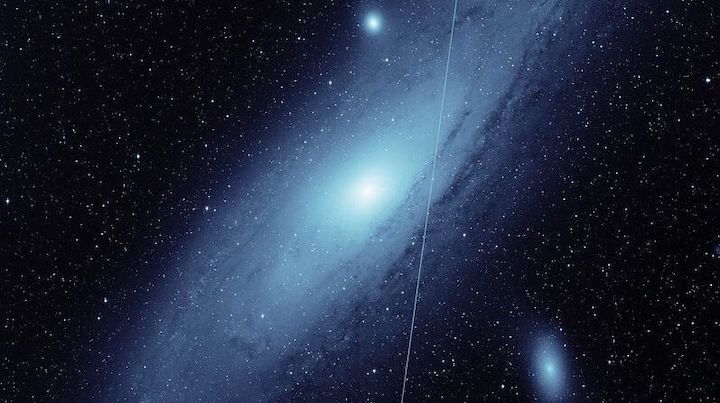18.01.2022
SpaceX's approved satellites will mean all this telescope's images will have tracks.

A Starlink track running across the Andromeda galaxy.
SpaceX's Starlink Internet service will require a dense constellation of satellites to provide consistent, low-latency connectivity. The system already has over 1,500 satellites in orbit and has received approval to operate 12,000 of them. And that has astronomers worried. Although SpaceX has taken steps to reduce the impact of its hardware, there's no way to completely eliminate the tracks the satellites leave across ground-based observations.
How bad is the problem? A team of astronomers has used archival images from a survey telescope to look for Starlink tracks over the past two years. Over that time, the number of images affected rose by a factor of 35, and the researchers estimate that by the time the planned Starlink constellation is complete, pretty much every image from their hardware will have at least one track in it.
Looking widely
The hardware used for the analysis is called the Zwicky Transient Facility (ZTF) at the Palomar Observatory. The ZTF is designed to pick up rare events, such as supernovae. It does so by scanning the entire sky repeatedly, with software monitoring the resulting images to look for objects that were absent in early images but which appeared in later ones. The ZTF's high sensitivity makes it good for picking out dim objects, like asteroids, in our own Solar System.
To ease the task of rapidly scanning the entire sky, the ZTF relies on a very wide field of view and an equally large camera. This broad field of view, unfortunately, also increases the likelihood that an exposure will have a Starlink satellite in view.
To determine how often the presence of these satellites was picked up by the ZTF cameras, the team behind the new analysis took data on the orbits of all Starlink hardware and compared it to the area of the sky captured in every archival ZTF image. Once an image was identified as potentially capturing a satellite, software was used to detect the presence of a bright track across the image. All told, the analysis covered a roughly two-year period from November 2019 to September 2021.
This was during the time that SpaceX was rapidly building its Starlink constellation, and it definitely shows. At the start of the study period, when there were only about 100 Starlinks in orbit, it was relatively common to have a stretch of 10 days of observations where none were detected. By the time 500 were in orbit, those periods were in the past. And once there were over 1,500 Starlink satellites in orbit, the ZTF would commonly image over 200 in a 10-day period.

Each blue bar represents the number of Starlink tracks over a 10-day period of observation. The red line tracks the total number of Starlink satellites.
Twilight observations were especially affected due to the confluence of two factors. Images that capture the horizon will include angles that show a lot more of the space occupied by Starlink orbits. And because of the Sun's position, more of these satellites are likely to be fully lit. As a result, about 64 percent of the tracks imaged were taken low in the sky at twilight. These tracks also saw explosive growth as the constellation of satellites filled in. In late 2020, only about 6 percent of the twilight images were affected. By late 2021, this figure grew to 18 percent.
Consequences
In response to complaints from the astronomy community, SpaceX put visors on later generations of Starlink satellites. The research team was able to compare the visibility of these different generations and found that the visors worked—satellites with visors dropped in brightness by a factor of roughly 4.6 (the precise number depended upon the wavelength). The visibility, however, was still higher than the target set at a workshop that was meant to address this issue.
Because these tracks are small and software already identifies and handles them, they don't have much of an effect on observations. The researchers estimate that, at present, there's only a 0.04 percent chance that a rare event will be missed because it coincides with a track. But because the problem is most acute in twilight observations, it's more likely to impact searches for objects within the Solar System. This would include comets and asteroids—including asteroids that originated around other stars.
But again, the problem is likely to get worse. SpaceX already has approval to increase the number of Starlink satellites to well over 10,000; the authors estimate that at 10,000, every image at twilight will likely contain a Starlink track. SpaceX has indicated it would eventually like to boost the numbers to over 40,000 satellites, at which point all twilight images are likely to have four tracks.
And SpaceX isn't the only company planning on this sort of satellite service. If all the companies involved follow through on their plans, low Earth orbit could see as many as 100,000 of these satellites.
Overall, the picture is mixed. The ZTF's main mission—to pick out rare events caused by distant, energetic phenomena—is largely unaffected by the growing number of satellite tracks. And because the percentage of events is currently small, tripling the number of satellites won't have a dramatic impact on observations. But a secondary science mission is already seeing a lot of light contamination, and matters are only going to get worse.
The Astrophysical Journal Letters, 2022. DOI: 10.3847/2041-8213/ac470a (About DOIs).
Quelle: arsTechnica
